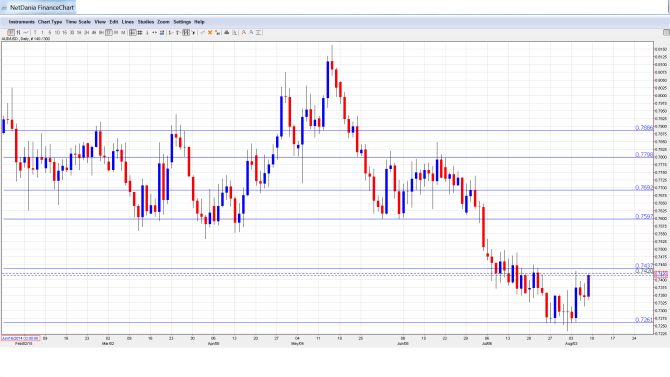AUD/USD posted its strongest weekly gain since March, jumping 120 points. The pair closed the week at 0.7415. This week’s highlight is NAB Business Confidence. Here is an outlook on the major market-movers and an updated technical analysis for AUD/USD.
The recovery of the A$ began when the RBA expressed less concern about its strength. Stevens and his colleagues surprised markets by acknowledging the fall in the local currency. Australian employment numbers were excellent, helping the Aussie post gains late in the week. In the US, NFP was slightly below expectations, which means the guessing game about the timing of rate hike by the Fed will continue.
[do action=”autoupdate” tag=”AUDUSDUpdate”/]AUD/USD graph with support and resistance lines on it. Click to enlarge:
- Chinese CPI: Sunday, 1:30. Chinese key events can have a substantial impact on the movement of AUD/USD, as the Asian giant is Australia’s number one trading partner. CPI improved to 1.4% in June, within expectations. Little change is expected in the July report.
- NAB Business Confidence: Tuesday, 1:30. Business Confidence jumped 10 points in June, its best showing since July 2014. Will the upswing continue in the July reading?
- Westpac Consumer Sentiment: Wednesday, 00:30. Consumer Sentiment is closely monitored by analysts, as stronger consumer confidence usually translates into increased consumer confidence, a key component of economic growth. The indicator has struggled, posting 3 declines in the past 4 months. The July reading came in at -3.2%.
- Wage Price Index: Wednesday, 1:30. Wage Price Index is a leading indicator of consumer inflation, and its quarterly publication magnifies the impact of each reading. The indicator dipped to 0.5% in Q2, within expectations. The forecast for Q3 stands at 0.6%.
- Chinese Industrial Production: Wednesday, 5:30. This key manufacturing indicator jumped 6.8% in June, marking a 4-month high, and easily beat the forecast of 6.0%. Another strong reading is expected in July, with an estimate of 6.7%.
- RBA Deputy Governor Philip Lowe Speaks: Wednesday, 10:00. Lowe will speak at an event in Perth. The markets will be looking for any hints regarding the RBA’s future interest rate policy.
- MI Inflation Expectations: Thursday, 1:00. This indicator helps analysts track inflation, as consumer expectations of inflation often translates into actual inflation. The indicator rose to 3.4% in June, compared to 3.0% a month earlier.
- RBA Deputy Governor Christopher Kent Speaks: Thursday, 2:15. Kent will speak at an event in Brisbane. A speech which are more hawkish than expected is bullish for the Australian dollar.
* All times are GMT.
AUD/USD Technical Analysis
AUD/USD opened the week at 0.7295 and quickly touched a low of 0.7260, testing support at 0.7266 (discussed last week). The pair then rebounded and climbed to a high of 0.7428. AUD/USD closed the week at 0.7415.
Live chart of AUD/USD: [do action=”tradingviews” pair=”AUDUSD” interval=”60″/]
Technical lines from top to bottom:
We start with resistance at 0.7886, which was last breached in late May.
0.7798 was an important resistance level for much of June.
0.7692 remains a strong resistance line.
0.7597 was an important support level in June.
0.7438 marked the start of a recent greenback rally, which saw the pair dip below the 0.73 line.
0.7266 was tested for a third straight week and is providing support.
0.7113 has held firm since April 2009.
0.7011 was a key support level in March 2006. It is protecting the symbolic line of 0.70.
0.6931 is the final support line.
I am bullish on USD/AUD
The Aussie posted strong gains last week, but strong numbers out of the US could fuel speculation about a September rate hike, which would send the greenback to higher levels. As well, the US economy is in better shape than its Australian counterpart, so the Australian dollar will be hard pressed to hold onto its recent gains.
In our latest podcast, we ask: Will they or won’t they? We talk about the Fed and also falling oil and silver.
Further reading:
- For a broad view of all the week’s major events worldwide, read the USD outlook.
- For EUR/USD, check out the Euro to Dollar forecast.
- For the Japanese yen, read the USD/JPY forecast.
- For GBP/USD (cable), look into the British Pound forecast.
- For the Canadian dollar (loonie), check out the Canadian dollar forecast.
- For the kiwi, see the NZDUSD forecast.

